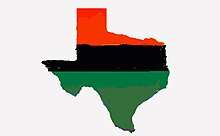History of African Americans in Texas
African Americans formed a unique ethnic identity in Texas while facing the problems of societal and institutional discrimination as well as colorism for many years. The first person of African heritage to arrive in Texas was Estevanico, who came to Texas in 1528.[1]

| Part of a series on |
| Ethnicity in Texas |
|---|
|
|
|
Population
Many African Americans in Texas remained in slavery until after the U.S. Civil War ended. There was scarce Union Army activity in Texas, preventing them from joining the Northern lines. Some escaped over the borders to areas where the Union Army was operating. The announcement of emancipation was delayed until June 19, 1865, when officials announced that slavery had been formally abolished. This is celebrated in Texas as Juneteenth.[1] African Americans left Texas by the tens of thousands during the Great Migration in the first half of the 20th century, seeking work and political opportunities elsewhere. As of the 2010 U.S. Census, African Americans were 11.9% of the state's population. The long-term effects of slavery can be seen to the present in the state's demographics. The eastern quarter of the state, where cotton production depended on thousands of slaves, is the westernmost extension of the Deep South and contains a very significant number of Texas' African-American population.[1]
Texas has one of the largest African-American populations in the country.[2] African Americans are concentrated in northern, eastern and east-central Texas as well as the Dallas, Houston and San Antonio metropolitan areas.[3] African Americans form 24 percent of both the cities of Dallas and Houston, 19% of Fort Worth, 8.1 percent of Austin, and 7.5 percent of San Antonio. The African American population in Texas is increasing due to the New Great Migration.[2][4] In addition to the descendants of the state's former slave population, many African American college graduates have come to the state for work recently in the New Great Migration.
A 2014 University of Texas at Austin study observed that the state's capital city of Austin was the only U.S. city with a high growth rate that was nevertheless losing African Americans, due to suburbanization and gentrification.[5]
In 2018, African-Americans had the second highest net growth in population in Texas compared to 2010. Harris County accounted for the largest percentage of that growth.[6] Harris County's largest city Houston is now known as a center of African-American political power, education, economic prosperity, and culture, often called the next black mecca.[7]
Higher education
There are seven historically black colleges and universities (HBCUs) in Texas. Texas Southern University (largest) and Prairie View A&M University (second largest) are the two most notable HBCUs in Texas and annually produce a significant portion of college degreed African-American in the state. The schools are also major SWAC sports rivals.[8][9]
See also
- History of African Americans in Houston
- History of African Americans in Dallas-Ft. Worth
- History of African Americans in San Antonio
- German Texan
- History of the Mexican-Americans in Texas
- Jewish history in Texas
- Estevanico
- Juneteenth
- Sweatt v. Painter
- Ivy Taylor
- J. California Cooper
- Barbara Jordan
- Joe Lockridge
- Ntozake Shange
References
- Dulaney, W. Marvin (July 25, 2016) [June 9, 2010]. "African Americans". Handbook of Texas (online ed.). Texas State Historical Association.
- Frey, William H. (May 2004). The New Great Migration: Black Americans' Return to the South, 1965–2000 (Report). The Brookings Institution. p. 1. Archived (PDF) from the original on April 28, 2008.
- "Texas – BlackDemographics.com".
- "Texas".
- Donahue, Emily and David Brown. "Austin's the Only Fast-Growing City in the Country Losing African-Americans" (Archive). KUT. Moody College of Communication at the University of Texas at Austin, Friday May 16, 2014. Retrieved on May 20, 2014.
- https://www.texastribune.org/2019/06/20/texas-hispanic-population-pace-surpass-white-residents/
- Graves, Earl G., Sr. (December 8, 2016). "Join us in Houston, America's Next Great Black Business Mecca". Black Enterprise. Archived from the original on August 20, 2019. Retrieved September 6, 2019.
- https://www.chron.com/sports/college/article/Texas-Southern-fends-off-Prairie-View-A-M-in-14968780.php
- https://www.click2houston.com/sports/2019/08/26/5-things-to-know-about-tsu-prairie-view-am-rivalry-in-annual-labor-day-classic/#:~:text=Five%20things%20to%20know%20about%20the%20TSU%2DPrairie%20View%20A%26M%20rivalry%3A&text=Texas%20Southern%20leads%20the%20series,%2C%20TSU%20won%2013%2D7.&text=The%20last%20four%20years%2C%20Prairie,last%20season's%2060%2D14%20win.
Further reading
- Glasrud, Bruce (March 2014). "Anti-Black Violence in 20th Century East Texas" (PDF). East Texas Historical Journal. - Article 13
- Tang, Eric and Chunhui Ren. "Outlier: The Case of Austin's Declining African-American Population" University of Texas at Austin. May 8, 2014. Archive of old URL.
- Hoffberger, Chase (2014-11-03). "The Case of Austin's Declining African-American Population". Austin Chronicle.